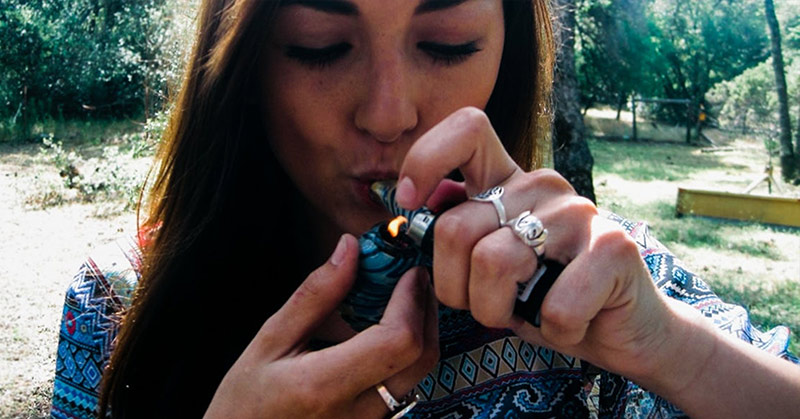Divorced mom Kaylie shocked a Dr. Phil audience when she revealed that she smokes marijuana with her daughter, Gabrielle. Fast-forward three years to when Hollywood A-lister Johnny Depp stood before a jury in court, defending his decision to give marijuana to his daughter when she was only eleven years old.
Over the last several years, the culture surrounding marijuana has shifted dramatically. It has been legalized in many countries around the world as well as several states, and more and the stigma around the drug is beginning to lessen considerably.
Despite this change in attitude, both of these stories have been circulated widely around the internet recently, with many viewers expressing their disapproval. This has opened up the debate as to whether or not marijuana is safe for young people, and how adults, specifically parents, should go about talking with their teenagers and children about the drug.
Mom smokes marijuana with her daughter before meditating
Kaylie, who at the time of the video had a prescription for medical marijuana, explained to Dr. Phil that she and her daughter liked to meditate together and that they would smoke weed before meditating.
She defended her decision to give the drug to her young daughter for two reasons. First, because she knew her daughter was already smoking and she was concerned about where she was getting the marijuana from, and second, she was worried about how much she was smoking in one sitting.
“She would smoke until she was just worthless. She couldn’t walk around or do anything. […] It really frightens me that she could get something horrible. Or that she’s just going to smoke and smoke and smoke until she’s blue, which is not the point,” said Kaylie [1].
For this reason, she decided that her best option was to be open with her daughter about smoking marijuana, and provide a safe and controlled environment within which her daughter could use the drug with parental supervision.
Some will argue that Kaylie was being a responsible parent, while others will argue the exact opposite. This leads us to ask the important question: how does marijuana affect teenagers?
Marijuana and Teens
Is there a danger for the mom who smokes marijuana with her daughter? Teenage marijuana use is the highest it’s been in thirty years, and today more teens are likely to smoke marijuana than tobacco. The legal age to purchase and smoke marijuana in the United States, however, is twenty-one [2].
While there have been scientific studies demonstrating the benefits of marijuana for adults, the same cannot be said for younger people. Teenagers, whose brains are still actively developing, are at a much greater risk for experiencing harmful and long-lasting effects to their health and well-being when they regularly smoke weed [3].
Some of the negative effects of marijuana on teenagers include:
- Difficulty thinking and problem solving.
- Problems with memory and learning.
- Impaired coordination.
- Difficulty maintaining attention.
- School difficulties [4]
- Use of other drugs or alcohol
- Risky sexual behaviours
- Worsening of underlying mental health conditions including mood changes and suicidal thinking [5]
- Increased risk of psychosis [6]
- Impaired driving [7]
- Interference with prescribed medication [2,3]
High levels of cannabis use among adolescents are also related to poorer educational outcomes, lower-income, greater welfare dependence and unemployment, and lower relationship and life satisfaction [8].
Why is marijuana more problematic for teenagers than older adults? The main reason is that the teenage brain does not fully develop until they’re in their mid-twenties. During this time, the brain is particularly sensitive to drug exposure, and marijuana use impacts how connections are formed within the brain interferes with neurotransmitters and causes abnormal brain shape and structure volume [9].
Teenagers are also more likely to pick up long-lasting habits, which puts them at greater risk for addiction to the drug as they get older. There is also evidence that the depressive effects of cannabis may last longer in teenagers than they do in adults [10].
A Brief History of Marijuana Education
Until recently, marijuana was illegal across the US. For this reason, before there was much research surrounding the effects of the drug on the teenage brain, there was significant effort put into educating young people on the dangers of the drug.
‘Just Saying No’ is Not so Easy
During the notorious “War on Drugs” in the 1980s, the “just say no” approach was the preferred educational method for marijuana and other drugs. The DARE (Drug Abuse Resistance Education) curriculum was introduced in schools, in which police officers visited schools to convince children that drugs were bad.
After a decade of using the program, which relied on law enforcement rather than medical science to educate young people, research found that it had little to no impact, and possibly even made drug use among adolescents and teens worse.
Ignoring Reality
The DARE program forced an abstinence-only policy, while completely ignoring the reality that teens and young adults sometimes experiment with drugs. Marsha Rosenbaum, Director Emerita for the Drug Policy Alliance, an organization which seeks a reality-based, harms reduction approach to drugs and drug abuse, says that the effort has gone into using misinformation to scare teenagers off of trying anything.
She has been a key contributor to the new, anti-DARE school curriculum entitled Safety First: A Reality-Based Approach to Teens and Drugs, which seeks to educate teens on how to limit harms regardless of the decisions they make.
“It’s got at its core the notion of harm reduction. That means that whereas the best choice for teenagers abstinence, hands down, the best choice. However, they make their own decisions. And sometimes they don’t decide to say ‘no’,” says Rosenbaum. “Accepting that reality is the first step, and then figuring out if you can’t have abstinence, what’s your plan B? What’s the fallback?” [1]
Talking to Teens About Drugs
Today, new programs are being put in place to educate teenagers with the understanding that abstinence across the board is unrealistic. One of these programs is the Students for Sensible Drug Policy (SSDP), an international organization of students and young people seeking changes toward a realistic drug policy. It is monitored by Vilmarie Narloch, Drug Education Manager for SSDP, and a practiced clinical psychologist with a focus on substance abuse disorders.
Narloch says that they will be talking about the developing brain and some of the risks that exist and what the research says, but also acknowledging that some students are already consuming cannabis. For that reason, they also need to consider what those students need to know in order to use the drug as safely as possible.
“We’re targeting students and young people that may already be using the substance,” says Vilmarie. “We acknowledge that young people are already using these drugs and we want to ensure that, since they are already doing so, give them the tools that allow them to do so in the safest way possible.” [1]
The program is in no way encouraging students to use marijuana, nor is it promoting drug use in any way, but it is one of the first major programs to acknowledge that many teenagers and college students don’t always “just say no”.
Talking to Your Child About Marijuana
Talking to your own child about marijuana can be difficult, especially given that it was an illegal substance for so long, but most experts agree that it is important for parents to talk to their kids about the drug.
Ruth Cordukes, a public health nurse in Canada, where marijuana is legal, says that it is very important to talk about it with school-age children.
“This is an age when it’s so easy to have these conversations. They’re not actively using it, so they’re not feeling any judgment. It’s more about answering curiosity. It’s a great opportunity for parents to tell youth what they, as parents, think before the child is actually faced with choices.” [11]
Follow Your Child’s Lead
She suggests following your child’s lead, and answering their questions as they come up (for example, when they ask what that funny smell is as you’re walking down the street). She also recommends using age-appropriate language, for example:
“It’s a plant you eat or smoke, and it changes how you feel. Some people use it for medicine. You should only use it if you’re an adult.”
She says it’s important to pay attention to your tone, and to be sure not to present it as a very intense topic, because they’ll remember that it made you anxious. Instead, the goal is to have a relaxed, easygoing conversation with your child so they know that it’s ok for them to talk about it.
Be Honest
She also emphasises that if you don’t know the answer to a question, don’t fake it- suggest to your child that you go and look it up together [11].
When it comes to teenagers, keeping the lines of communication open and honest is also the best way to ensure that your kids feel comfortable asking you questions about the drug.
Dr. Seth Ammerman, MD, has created a tip sheet of talking points for parents with their teenagers, that includes the potential effects the drug can have on their brains, the legal ramifications of underage use, and the dangers of driving while under the influence. It also includes advice on how to talk to teenagers about your own marijuana usage, and how to have discussions about various drug use scenarios [12].
The Bottom Line
Most parents, of course, would prefer their children stay away from all types of drugs, however we know that expecting one hundred percent abstinence is not realistic.
While we certainly do not want to be encouraging young people to use drugs of any kind, it is important that we don’t make them feel as though they can’t ask questions. We want to educate them properly on the risks associated with doing drugs and help them to make responsible choices, but if they are already experimenting with them, we need to offer them tools to use them as safely as possible.
While not every parent will feel comfortable openly using marijuana with their children like Kaylie or Johnny Depp, finding an approach that allows you to have continuous conversation about drugs with your child is the best way to ensure their health and safety.
Keep Reading: World’s first marijuana gym opening in California
Sources
- “Why This Mom Loves Smoking Weed With Her 14-Year-Old Daughter.” Herb
- “Marijuana and Teens.” AACAP. October 2019.
- “What You Need to Know About Marijuana Use in Teens.” CDC
- “Acute and Chronic Effects of Cannabinoids on Human Cognition-A Systematic Review.” PubMed. Samantha J Broyd, et al. April 2016.
- “Changes in cannabis use among young people: impact on mental health.” PubMed. Jan Copeland, et al. July 1013.
- “Cannabis use in adolescence and risk for adult psychosis: longitudinal prospective study.” NCBI. Louise Arseneault, et al. November 2002.
- “Cannabis and its effects on driving skills.” PubMed. Percy Bondallaz, et al. November 2016.
- “Cannabis use and later life outcomes.” Wiley. David M. Fergusson, Joseph M. Boden. June 28, 2008.
- “The influence of substance use on adolescent brain development.” PubMed. L M Squeglia, et al. January 2009.
- “Cannabis use in teens linked to risk of depression in young adults.” Science daily. February 13, 2019.
- “How to talk to your kids about cannabis.” Todays Parent. Bonnie Schiedel. June 27, 2019.
- “Talking with your teen about marijuana use.” Standford Children. Kate DeTrempe. July 19, 2018.

